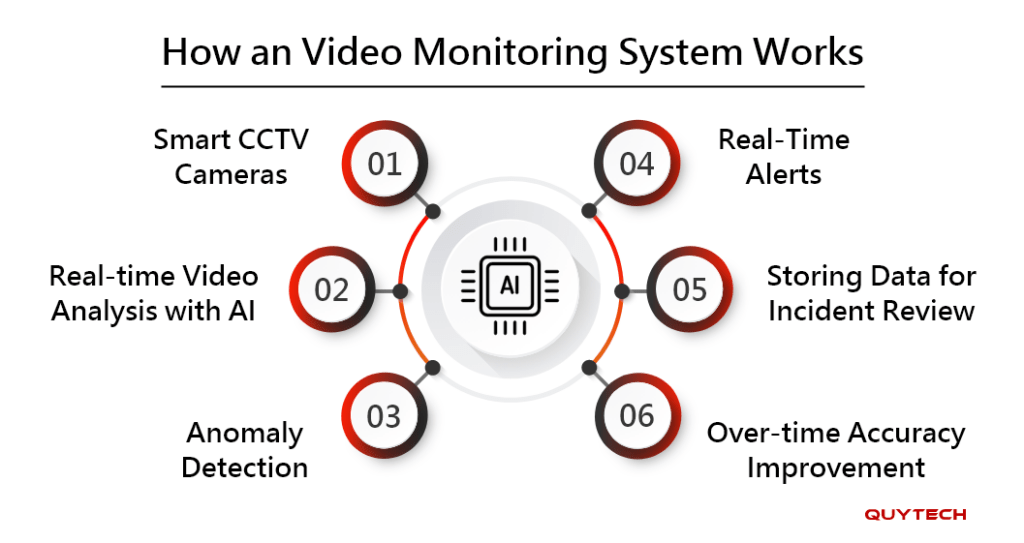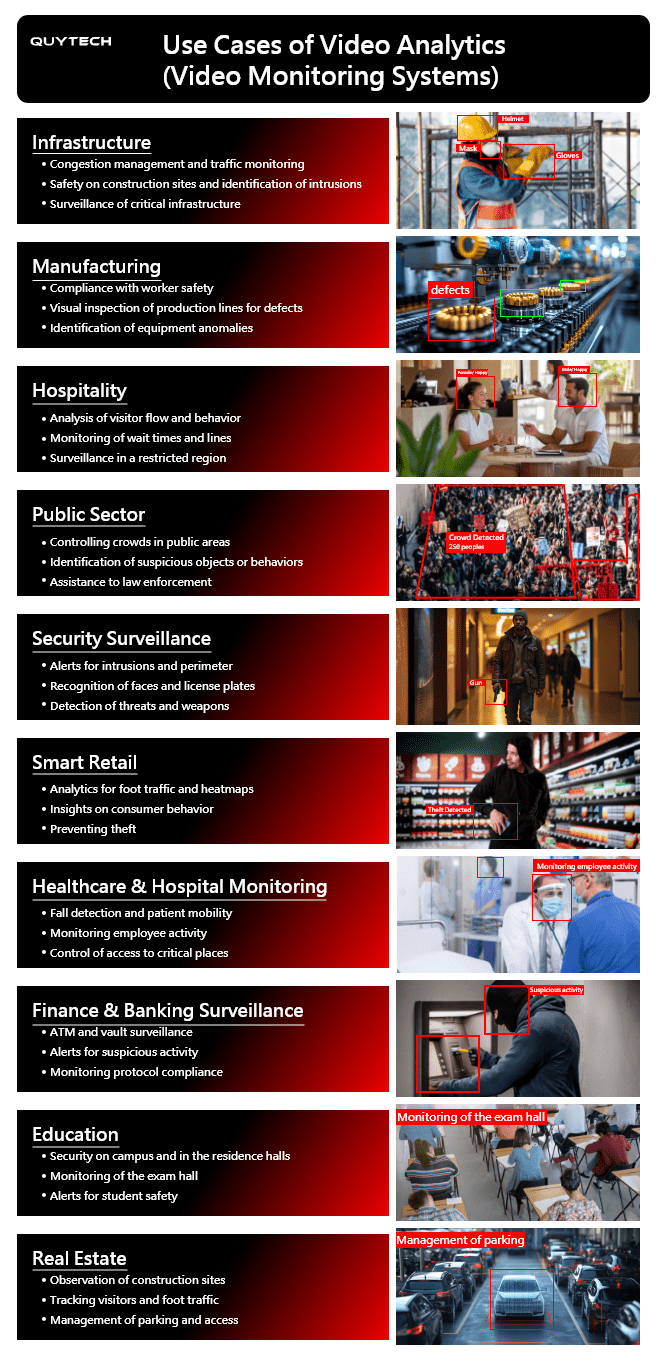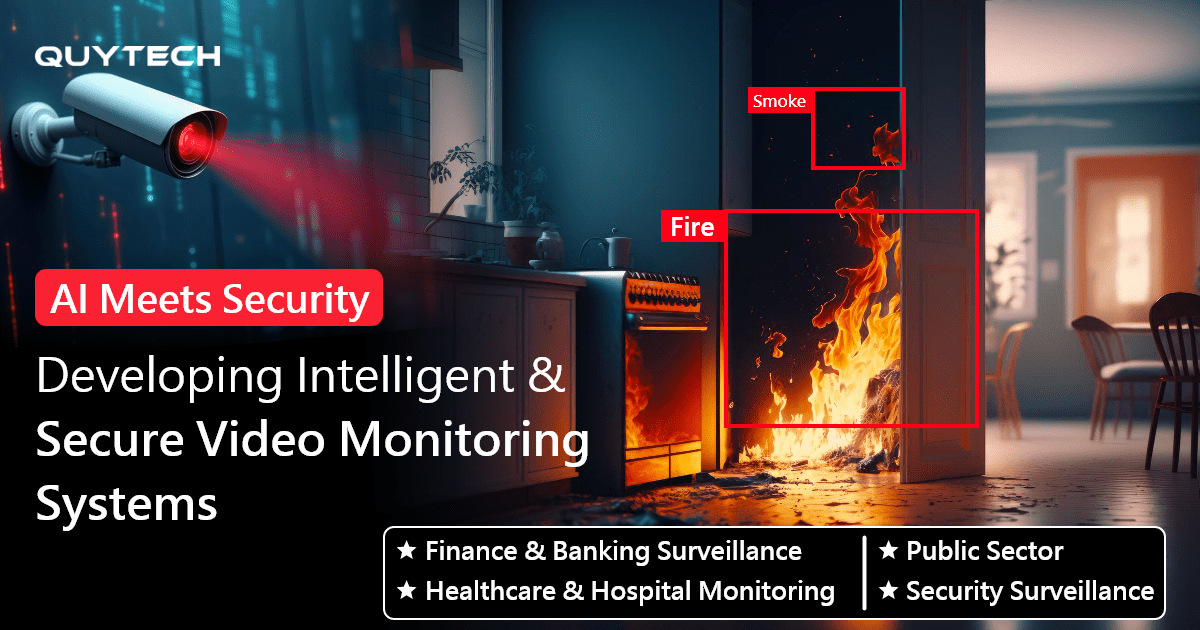Imagine a scenario of a normal day in a workplace, and a fire breaks out suddenly, and nobody notices. The traditional video surveillance system will record the whole scene. But it will not send any warning signals or alerts to anyone. By the time somebody notices it, the damage will have been done already.
Now, picture a video monitoring system that detects smoke, analyzes the situation, and sends out alerts and warnings, taking safety measures in real-time. These are the features of an AI-based video monitoring system. It excels in accurately detecting any kind of threats, be it theft, fights, fall detection, patient monitoring, etc.
Through this blog, you will explore the mechanism, core features, key advantages, and the development process of an AI-based video monitoring system.
AI-based Video Monitoring System: Market Stats
- According to Market and Markets, the AI-based video surveillance market is expected to reach $4.74 billion by 2025 and is projected to reach $12.46 billion at a CAGR of 21.3% in the year 2030.
- Based on a report on the AI-based video monitoring market, it generated about $1.06 billion in 2024 in the healthcare sector.
The Role of AI in Video Monitoring Systems
Conventional video surveillance systems work passively by simply observing and recording the incidents taking place. Although it does provide a record of what happened but is accessed only after an incident has already taken place. It can show what is damaged and by whom, but it fails to stop the damage from happening. It follows a reactive approach and is often overlooked and delayed, as it is human-operated.
AI reshapes this landscape by offering a proactive approach that does not offer a mere recording but acts on it with real-time analysis, detection, and alert warnings. AI in video monitoring systems utilizes computer vision, machine learning, etc., to detect threats in real time, followed by alerts and warning signals to the administration. It plays a vital role in minimizing false alarms, maximizing efficiency, and enhancing accuracy related to threat detection and action.
Read More: AI Video Analytics in Retail: CCTV Security Solution
How an AI-based Video Monitoring System Works
Utilizing multiple advanced features along with the traditional system, an AI-based video monitoring system functions by:

- Smart CCTV Cameras
Similar to traditional video surveillance systems, an AI-based video monitoring system also captures and collects video footage. Captured video is then sent for processing to the monitoring system, which can be in-office, edge, or cloud.
- Real-time Video Analysis with AI
With the help of artificial intelligence, the monitoring system analyzes each and every frame in the video captured. It utilizes computer vision along with machine learning to accurately detect anything unusual in the video.
- Anomaly Detection
The system is trained for what is normal in a particular environment. If it senses something unusual during the footage analysis, it compares it to the baseline of differentiation and then flags it as a deviation.
- Real-Time Alerts
Once it confirms the incident occurring as an ‘unusual’ activity, it sends real-time alerts and warning signals to the security systems. In certain cases, it may also automate security responses like activating sirens, alerting emergency services, etc.
- Storing Data for Incident Review
AI-powered video surveillance does more than simply detect. It stores the videos as well for future auditing, reporting, and investigating. It also detects the frequency of some incidents occurring at a certain place or time to enhance existing security measures.
- Over-time Accuracy Improvement
The AI models do not stay static; they improve with each incident and get trained for the future. This helps the security system be proactive. With time, its accuracy in detecting threats increases, and it updates and refines with the changes thereafter.
Key Features of an AI-based Video Monitoring System
An AI-supported video surveillance system comes feature-loaded. Here are some of its features:
Real-Time Threat Detection
Real-time video analytics works by processing the video to interpret it. AI utilizes deep learning models to break down each video frame into data helpful in detecting threats. It can instantly detect intrusions, fire, or any unusual activity through video analysis.
Automated Anomaly Alerts
When the system detects any unusual activity, like unauthorized personnel entering staff-accessed areas, it sends security alerts. The warning signals alert the security teams, and they act based on the emergency thereafter.
Proactive Security Measures
The AI-driven CCTV system does not just send alerts but also takes appropriate safety actions. Once it identifies a certain type of anomaly, for example, fire breaking out, it sends alerts and then activates evacuation sirens.
Data-Driven Insights
Apart from sending alerts and taking proactive safety measures, AI-video analytics also provides insights. It analyzes data collected and looks for frequently recurring incidents and patterns of certain anomalies. It helps in improving security preparedness based on data-driven insights.
Reduced Human Error
An AI-based video monitoring system does not depend on human operation to perform basic detection and alerting activities. This makes the system free from human error and oversight, making it more accurate.
Faster Incident Response
AI-driven CCTV monitoring instantly detects threats. This cuts the time spent on realizing unusual activity, identifying it, and then going through footage for a better grasp of the situation. This instant action prevents damage of any form.
From Concept to Deployment: Building AI Video Monitoring Systems
AI-based CCTV video monitoring systems utilize a bunch of different interconnected hardware, software, and AI models. The following steps guide the development process of an AI-driven video analytics system:

Requirement Gathering & Use Case Definition
The first step includes identifying the use cases and the requirements to work on them. It includes deciding the areas that need to be monitored, like unauthorized access, fire threats, facial recognition, etc. This step ensures that the idea and the planned system are aligned.
System Architecture Design
After deciding on the use case and other requirements, the next step is to design the system architecture. These decisions include selecting the system type, camera and sensor placements, AI models, storage systems, front-end architecture, etc. Architecture is decided keeping in mind the processes of the systems that it will be supporting.
Technology Stack Finalization
The next step involves making decisions for the types of technology stack that you will be using to develop your video monitoring system. These decisions comprise the type of database, AI frameworks, programming languages, UI decisions, etc. The stack is decided based on the system’s needs.
AI Model Development & Training
AI model development involves deciding the areas where artificial intelligence will be assisting. It includes facial recognition, object detection, etc. The step decides the type of AI models to be used and how they will be trained. Training of the models will depend on the environment they are created.
Real-Time Video Processing Pipeline
Real-time video processing pipelines include deciding the pipelines that would continuously feed real-time captured videos into the monitoring system for interpretation and processing. It should be chosen to keep in mind that it does not crash or lag while processing the videos.
Alerting & Notification System
The alerting system should be seamlessly integrated with the channels through which it will be connected, like SMS, mobile applications, etc. It should also incorporate an automated response stage, like activating sirens, alarms, etc.
Dashboard & Admin Panel
After the successful integration of an alerting system, the AI video monitoring system would now require an interface. This interface will help the users, security teams, administrators, etc., to check the activity logs, incident history, threat notifications, etc. The design should have role-based access and controls for smooth operation.
Storage & Data Management
Storage and data management includes deciding the form of storage options, like cloud-based storage, on-premises storage, etc. It should be decided keeping in mind that the video data may grow in the future and require a scalable solution. Footage stored should be indexed and time-stamped for easy retrieval when needed.
Edge AI Deployment (If Needed)
Integration of edge AI allows the system to make critical decisions instantly without forwarding the video captured anywhere. These are installed to make the system faster and more private. It also efficiently takes necessary actions when the internet connection is not very favorable.
Testing & QA
After the successful integration of every needed component, the AI video analytics monitoring system goes under testing. The testing is done under various circumstances, like low lighting, crowded areas, varied angles, etc. These quality assurance steps ensure that the system works accurately and does not give a false positive output in certain situations.
Security & Compliance
The video data captured and stored can be sensitive and confidential. To ensure that it stays protected and regulated, the system is incorporated with various data protection stages like encryption, access control, activity monitoring, etc. Required security measures and relations are complied with as well.
Deployment & Maintenance
After checking all the above boxes, the next step is to deploy the system in a live environment. This includes hardware decisions, network infrastructure, etc. Post-deployment, the system should be monitored to look for possible vulnerabilities and should be updated regularly.
Read More: AI-Powered Video Analytics for Public Sector
Use Cases of Video Analytics (Video Monitoring Systems) Across the Industries
The following are the use cases that demonstrate how AI video surveillance is playing a prominent role in improving several industries:

Smarter, Safer, Faster: The Advantages of AI Surveillance Cameras
With the perfect balance of traditional surveillance and artificial intelligence advancements, smart surveillance systems come with the following core advantages:
Smarter Incident Response
The AI features in the CCTV surveillance system enable it to detect threats in real time. This allows the security team to respond instantly. Timely action helps in preventing losses or further damage.
24/7 Uninterrupted Monitoring
The AI-powered video analytics system does not get tired or distracted like humans. It stays alert all the time, be it day or night, and does not depend on human operators to perform its tasks.
Proactive Safety Measures
Being a system that responds in real-time to threats, the AI-based video monitoring system does more than just notify. It is integrated with systems like emergency alarms, door locking, contacting emergency responders, etc. It proactively takes these safety measures when needed.
Cost-Efficient Operations Over Time
An AI-based video surveillance system may require an upfront investment during installation, but it is a very cost-effective option in the long run. It does not require staff-intensive monitoring and requires minimal human interaction. Hence, proving to be a worthy investment.
Environmental Adaptability
The AI utilized in the video monitoring system enables it to adjust to the lighting, weather conditions, or industrial environment. Environment adaptability often hinders traditional surveillance systems, but AI-powered systems adjust to requirements seamlessly.
Intelligent Insights
AI models in the monitoring system are trained in a way that they depict patterns and trends of certain events that happen at a certain time. This enhances preparedness and safety measures required beforehand.
Read More: AI-Enabled Video Analysis: Everything You Need to Know
Partner with Quytech to Build Robust AI-Based Monitoring Systems
At Quytech, we help businesses enhance the way their surveillance systems work and employ a more secure monitoring system. With decades of experience and a team that works wonders and brings your vision to life, we provide solutions made for you.
Quytech ensures that our AI video monitoring system is packed with features that not only perform the basic functions of a CCTV monitoring system but also encompass smart functions. With top-notch functionality and adaptability, we don’t just create new monitoring systems but also cater to specific needs, like integrating AI into your existing surveillance systems.
Conclusion
The traditional systems work fine, but when it comes to being proactive, AI-based video monitoring systems become a necessity. To plan and prevent any sort of damage to the business and people, switching to an AI CCTV surveillance system is a step that matters.
With features like threat detection and proactive safety measures, the AI video monitoring system contributes immensely towards providing a safe and secure environment for people. The switch is not merely towards technology but also towards a system that is there to monitor every little detail without being dependent on human operators.
FAQ’s
Yes, the AI surveillance system can easily be integrated into your existing monitoring systems. This can be a very cost-effective step without needing to change the existing hardware.
Yes, the AI-powered surveillance system works perfectly even in low-light environments, as it is an adaptable system. It can maintain quality and accuracy in challenging conditions.
Yes, the AI-based video monitoring systems reduce false positives as they are trained and have an accurate analysis. They take notifying steps only after being certain about the threats.
Yes, the video data captured through an AI video surveillance system is safe and secure, as the system is made with required regulatory compliance. The data saved is encrypted for added security.



